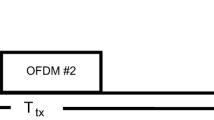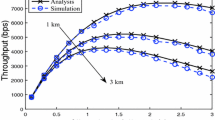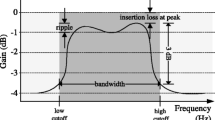Abstract
This is the second in a two-part series of papers on information-theoretic capacity scaling laws for an underwater acoustic network. Part II focuses on a dense network scenario, where nodes are deployed in a unit area. By deriving a cut-set upper bound on the capacity scaling, we first show that there exists either a bandwidth or power limitation, or both, according to the operating regimes (i.e., path-loss attenuation regimes), thus yielding the upper bound that follows three fundamentally different information transfer arguments. In addition, an achievability result based on the multi-hop (MH) transmission is presented for dense networks. MH is shown to guarantee the order optimality under certain operating regimes. More specifically, it turns out that scaling the carrier frequency faster than or as \(n^{1/4}\) is instrumental towards achieving the order optimality of the MH protocol.


Similar content being viewed by others
Notes
We use the following notation: (i) \(f(x)=O(g(x))\) means that there exist constants \(C\) and \(c\) such that \(f(x)\le Cg(x)\) for all \(x>c\). (ii) \(f(x)=o(g(x))\) means that \(\lim \nolimits _{x\rightarrow \infty }\frac{f(x)}{g(x)}=0\). (iii) \(f(x)=\varOmega (g(x))\) if \(g(x)=O(f(x))\). iv) \(f(x)=\omega (g(x))\) if \(g(x)=o(f(x))\). v) \(f(x)=\varTheta (g(x))\) if \(f(x)=O(g(x))\) and \(g(x)=O(f(x))\) [13].
References
Shin, W.-Y., Lucani, D. E., Médard, M., Stojanovic, M., & Tarokh, V. (2012). On the order optimality of large-scale underwater networks–Part I: Extended network model. Wireless Personal Communications. doi:10.1007/s11277-012-0904-Z
Franceschetti, M., Dousse, O., Tse, D. N. C., & Thiran, P. (2007). Closing the gap in the capacity of wireless networks via percolation theory. IEEE Transactions on Information Theory, 53(3), 1009–1018.
Jovicic, A., Viswanath, P., & Kulkarni, S. R. (2004). Upper bounds to transport capacity of wireless networks. IEEE Transactions on Information Theory, 50(11), 2555–2565.
Özgür, A., Lévêque, O., & Tse, D. N. C. (2007). Hierarchical cooperation achieves optimal capacity scaling in ad hoc networks. IEEE Transactions on Information Theory, 53(10), 3549–3572.
Xie, L.-L., & Kumar, P. R. (2004). A network information theory for wireless communication: Scaling laws and optimal operation. IEEE Transactions on Information Theory, 50(5), 748–767.
Xue, F., Xie, L.-L., & Kumar, P. R. (2005). The transport capacity of wireless networks over fading channels. IEEE Transactions on Information Theory, 51(3), 834–847.
Gupta, P., & Kumar, P. R. (2000). The capacity of wireless networks. IEEE Transactions on Information Theory, 46(2), 388–404.
El Gamal, A., Mammen, J., Prabhakar, B., & Shah, D. (2006). Optimal throughput-delay scaling in wireless networks-part I: The fluid model. IEEE Transactions on Information Theory, 52(6), 2568–2592.
Özgür, A., Johari, R., Tse, D. N. C., & Lévêque, O. (2010). Information-theoretic operating regimes of large wireless networks. IEEE Transactions on Information Theory, 56(1), 427–437.
Urick, R. J. (1983). Principles of underwater sound. New York: McGraw-Hill.
Stojanovic, M. (2007). On the relationship between capacity and distance in an underwater acoustic communication channel. ACM SIGMOBILE Mobile Computing and Communications, Review (MC2R), 11(4), 34–43.
Berkhovskikh, L., & Lysanov, Y. (1982). Fundamentals of ocean acoustics. New York: Springer.
Knuth, D. E. (1976). Big omicron and big omega and big theta. ACM SIGACT News, 8, 18–24.
Coates, R. (1989). Underwater acoustic systems. New York: Wiley.
Cover, T. M., & Thomas, J. A. (1991). Elements of information theory. New York: Wiley.
Shin, W.-Y., Jeon, S.-W., Devroye, N., Vu, M. H., Chung, S.-Y., Lee, Y. H., et al. (2011). Improved capacity scaling in wireless networks with infrastructure. IEEE Transactions on Information Theory, 57(8), 5088–5102.
Constantinescu, F., & Scharf, G. (1998). Generalized Gram-Hadamard inequality. Journal of Inequalities and Applications, 2, 381–386.
Lucani, D. E., Médard, M., & Stojanovic, M. (2008). Capacity scaling laws for underwater networks. In Proceedings of asilomar conference on signals, systems and computers (pp. 2125–2129).
Acknowledgments
This research was supported by Basic Science Research Program through the National Research Foundation of Korea (NRF) funded by the Ministry of Education, Science and Technology (2012R1A1A1044151), by the Air Force Office of Scientific Research (AFOSR) under award No. 016974-002, by the National Science Foundation under grant No. 501731, and by the ONR grant No. 599257. This material in this paper was presented in part at the Asilomar Conference on Signals, Systems, and Computers, Pacific Grove, CA, November 2011.
Author information
Authors and Affiliations
Corresponding author
Appendix
Appendix
1.1 Proof of Lemma 1
Upper and lower bounds on \(P_L^{(k)}\) in a dense network are derived by basically following the same node indexing and layering techniques as those in Part I. We refer to Appendix A.2 and Figure 4 in [1] for the detailed description (note that the destination nodes are, however, located at positions \(\left(\frac{k_x}{\sqrt{n}}, \frac{k_y}{\sqrt{n}}\right)\) in dense networks). Similarly to the extended network case, from (9), the term \(P_{L}^{(k)}\) is then given by
First, focus on how to obtain an upper bound for \(P_{L}^{(k)}\). Assuming that all the nodes in each layer are moved onto the innermost boundary of the corresponding ring, we then have
for some positive constants \(c_0\), \(c_5\), and \(c_6\) independent of \(n\) and an arbitrarily small \(\epsilon _0>0\), where the equality comes from the relationship (8) between \(a(f)\) and \(\beta \). We first consider the case where \(k_x=o\left(n^{1/2-\beta +\epsilon }\right)\) for an arbitrarily small \(\epsilon >0\). Under this condition, from the fact that the term \(i^{\prime \alpha -1}\) in the RHS of (20) is dominant in terms of upper-bounding \(P_{L}^{(k)}\) for \(i^{\prime }=k_x,\ldots ,\sqrt{n}\), (20) is further bounded by
which yields \(P_{L}^{(k)}=O\left(n^{\alpha /2}(\sqrt{n})^{2-\alpha }\right)=O(n)\) for \(1\le \alpha <2\) and \(P_{L}^{(k)}=O\left(n\log n\right)\) for \(\alpha =2\). When \(k_x=\varOmega (n^{1/2-\beta +\epsilon })\), the upper bound (20) for \(P_{L}^{(k)}\) is dominated by the term \(\left(1+\epsilon _0\right)^{i^{\prime }n^{\beta -1/2}}\), and thus is given by
for some constant \(c_7>0\) independent of \(n\), which is the last result in (10).
Next, let us turn to deriving a lower bound for \(P_{L}^{(k)}\). Since each layer has at least one node that is onto the innermost boundary of the corresponding ring, the lower bound similarly follows
For the condition \(k_x=o(n^{1/2-\beta +\epsilon })\), (22) is represented as
for an arbitrarily small \(\epsilon ^{\prime }>0\) and some constant \(c_8>0\) independent of \(n\), where the third inequality holds due to \(\left(1+\epsilon _0\right)^{k_x n^{\beta -1/2}}=O(n^{\epsilon ^{\prime }})\). On the other hand, similarly as in the steps of (21), the condition \(k_x=\varOmega (n^{1/2-\beta +\epsilon })\) yields the following lower bound for \(P_{L}^{(k)}\):
some constant \(c_9>0\) independent of \(n\), which finally complete the proof of the lemma.
1.2 Proof of Lemma 2
The layering technique used in Part I is similarly applied (see Fig. 2 in [1]). From (1), the total interference power \(P_I\) at each node from simultaneously transmitting nodes is upper-bounded by
Using (4) and (8), the upper bound (23) on \(P_I\) can be expressed as
for some positive constants \(c_{10}\) and \(c_{11}\) independent of \(n\). Based on the argument in Appendix 6.1, when \(0\le \beta <1/2\), it follows that
which results in \(P_I=O\left(\frac{\max \left\{ n^{(1/2-\beta )(2-\alpha )},\log n\right\} }{n^{\beta a_0/2}}\right)\). This completes the proof of the lemma.
Rights and permissions
About this article
Cite this article
Shin, WY., Lucani, D.E., Médard, M. et al. On the Effects of Frequency Scaling Over Capacity Scaling in Underwater Networks—Part II: Dense Network Model. Wireless Pers Commun 71, 1701–1719 (2013). https://doi.org/10.1007/s11277-012-0982-y
Published:
Issue Date:
DOI: https://doi.org/10.1007/s11277-012-0982-y




